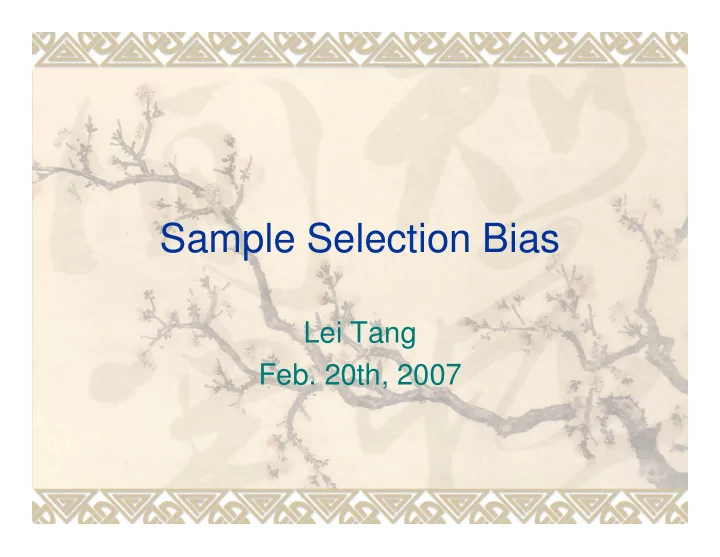

Sample Selection Bias Lei Tang Feb. 20th, 2007
Classical ML vs. Reality � Training data and Test data share the same distribution (In classical Machine Learning) � But that’s not always the case in reality. � Survey data � Survey data � Species habitat modeling based on data of only one area � Training and test data collected by different experiments � Newswire articles with timestamps
Sample selection bias � Standard setting: data (x,y) are drawn independently from a distribution D � If the selected samples is not a random samples of D, then the samples are biased. of D, then the samples are biased. � Usually, training data are biased, but we want to apply the classifier to unbiased samples.
Four cases of Bias(1) � Let s denote whether or not a sample is selected. � P(s=1|x,y) = P(s=1) (not biased) � P(s=1|x,y) = P(s=1|x) (depending only on the feature vector) feature vector) � P(s=1|x,y) = P(s=1|y) (depending only on the class label) � P(s=1|x,y) (depending on both x and y)
Four cases of Bias(2) � P(s=1|x, y)= P(s=1|y): learning from imbalanced data. Can alleviate the bias by changing the class prior. � P(s=1|x,y) = P(s=1|x) imply P(y|x) remain � P(s=1|x,y) = P(s=1|x) imply P(y|x) remain unchanged. This is mostly studied. � If the bias depends on both x and y, lack information to analyze.
An intuitive Example P(s=1|x,y) = P(s=1|x) => s and y are independent. So P(y|x, s=1) = P(y|x). Does it really matter as P(y|x) remain unchanged??
Bias Analysis for Classifiers(1) � Logistic Regression Any classifiers directly models P(y|x) won’t be affected by bias � Bayesian Classifier But for naïve Bayesian classifier
Bias Analysis for Classifiers(2) � Hard margin SVM: no bias effect. Soft margin SVM: has bias effect as the cost of misclassification might change. � Decision Tree usually results in a different classifier if the bias is presented � In sum, most classifiers are still sensitive to the sample bias. � This is in asymptotic analysis assuming the samples are “enough”
Correcting Bias � Expected Risk: � Suppose training set from Pr , test set from Pr’ � So we minimize the empirical regularized risk:
Estimate the weights � ������������������������������������������������������������������ ������������� � But how to estimate the weight of each sample? � Brute force approach: � Estimate the density of Pr(x) and Pr’(x), respectively, � Then calculate the sample weight. � Not applicable as density estimation is more difficult than classification given limited number of samples. � Existing works use simulation experiments in which both Pr(x) and Pr’(x) are known (NOT REALISTIC)
Distribution Matching � The expectation in feature space: � We have � Hence, the problem can be formulated as � Solution is:
Empirical KMM optimization where Therefore, it’s equivalent to solve the QP problem:
Experiments � A Toy Regression Example
Simulation � Select some UCI datasets to inject some sample selection bias into training, then test on unbiased samples.
Bias on Labels
Unexplained � From theory, the importance sampling should be the best, why KMM performs better? � Why kernel methods? Can we just do the matching using input features? input features? � Can we just perform a logistic regression to estimate \beta by treating test data as positive class, and training data as negative. Then, \beta is the odds.
Some Related Problems � Semi-supervised Learning (Is it equivalent??) � Multi-task Learning: assume P(y|x) to be different. But sample selection bias(mostly) different. But sample selection bias(mostly) assume P(y|x) to be the same. MTL requires training data for each task. � Is it possible to discriminate features which introduce the bias? Or find invariant dimensionalities?
Any Questions? Happy Pig Year!
Recommend
More recommend